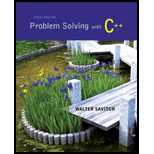
Concept explainers
My mother always took a little red counter to the grocery store. The counter was used to keep a tally of the amount of money she would have spent so far on that visit to the store, if she bought all the items in her basket. There was a four-digit display, increment buttons for each digit, and a reset button. There was an overflow indicator that came up red if more money was entered than the $99.99 it would register. (This was a long time ago.) Write and implement the member functions of a class Counter that simulates and slightly generalizes the behavior of this grocery store counter. The constructor should create a Counter object that can count up to the constructor’s argument. That is, Counter(9999) should provide a counter that can count up to 9999. A newly constructed counter displays a reading of 0. The member function void reset(); sets the counter’s number to 0. The member functions void incr1(); increments the units digit by 1, void incr10(); increments the tens digit by 1, and void incr100(); and void incr1000(); increment the next two digits, respectively. Accounting for any carry when you increment should require no further action than adding an appropriate number to the private data member. A member function bool overflow(); detects overflow. (Overflow is the result of incrementing the counter’s private data member beyond the maximum entered at counter construction.)
Use this class to provide a simulation of my mother’s little red clicker. Even though the display is an integer, in the simulation, the rightmost (lowerorder) two digits are always thought of as cents and tens of cents, the next digit is dollars, and the fourth digit is tens of dollars.
Provide keys for cents, dimes, dollars, and tens of dollars. Unfortunately, no choice of keys seems particularly mnemonic. One choice is to use the keys asdfo: a for cents, followed by a digit 1 to 9; s for dimes, followed by digits 1 to 9; d for dollars, followed by a digit 1 to 9; and f for tens of dollars, again followed by a digit 1 to 9. Each entry (one of asdf followed by 1 to 9) is followed by pressing the Return key. Any overflow is reported after each operation. Overflow can be requested by pressing the o key.
Want to see the full answer?
Check out a sample textbook solution
Chapter 10 Solutions
Problem Solving with C++ plus MyProgrammingLab with Pearson eText-- Access Card Package (9th Edition)
Additional Engineering Textbook Solutions
Starting Out with Java: From Control Structures through Data Structures (4th Edition) (What's New in Computer Science)
Starting Out with C++ from Control Structures to Objects (9th Edition)
INTERNATIONAL EDITION---Engineering Mechanics: Statics, 14th edition (SI unit)
Starting Out with Python (4th Edition)
Concepts Of Programming Languages
Java How to Program, Early Objects (11th Edition) (Deitel: How to Program)
- True or False: Given the sets F and G with F being an element of G, is it always ture that P(F) is an element of P(G)? (P(F) and P(G) mean power sets). Why?arrow_forwardCan you please simplify (the domain is not empty) ∃xF (x) → ¬∃x(F (x) ∨ ¬G(x)). Foarrow_forwardHistogramUse par(mfrow=c(2,2)) and output 4 plots with different argument settings.arrow_forward
- (use R language)Scatter plot(a). Run the R code example, and look at the help file for plot() function. Try different values for arguments:type, pch, lty, lwd, col(b). Use par(mfrow=c(3,2)) and output 6 plots with different argument settings.arrow_forward1. Draw flow charts for each of the following;a) A system that reads three numbers and prints the value of the largest number.b) A system reads an employee name (NAME), overtime hours worked (OVERTIME), hours absent(ABSENT) and determines the bonus payment (PAYMENT).arrow_forwardScenario You work for a small company that exports artisan chocolate. Although you measure your products in kilograms, you often get orders in both pounds and ounces. You have decided that rather than have to look up conversions all the time, you could use Python code to take inputs to make conversions between the different units of measurement. You will write three blocks of code. The first will convert kilograms to pounds and ounces. The second will convert pounds to kilograms and ounces. The third will convert ounces to kilograms and pounds. The conversions are as follows: 1 kilogram = 35.274 ounces 1 kilogram = 2.20462 pounds 1 pound = 0.453592 kilograms 1 pound = 16 ounces 1 ounce = 0.0283 kilograms 1 ounce = 0.0625 pounds For the purposes of this activity the template for a function has been provided. You have not yet covered functions in the course, but they are a way of reusing code. Like a Python script, a function can have zero or more parameters. In the code window you…arrow_forward
- make a screen capture showing the StegExpose resultsarrow_forwardWhich of the following is not one of the recommended criteria for strategic objectives? Multiple Choice a) realistic b) appropriate c) sustainable d) measurablearrow_forwardManagement innovations such as total quality, benchmarking, and business process reengineering always lead to sustainable competitive advantage because everyone else is doing them. a) True b) Falsearrow_forward
- Vision statements are more specific than strategic objectives. a) True b) Falsearrow_forwardThe three components of the __________ approach to corporate accounting include financial, environmental, and social performance measures. Multiple Choice a) stakeholder b) triple dimension c) triple bottom line d) triple efficiencyarrow_forwardCompetitors, as internal stakeholders, should be included in the stakeholder management consideration of a company and in its mission statement. a) True b) Falsearrow_forward
- Programming Logic & Design ComprehensiveComputer ScienceISBN:9781337669405Author:FARRELLPublisher:Cengage
 New Perspectives on HTML5, CSS3, and JavaScriptComputer ScienceISBN:9781305503922Author:Patrick M. CareyPublisher:Cengage Learning
New Perspectives on HTML5, CSS3, and JavaScriptComputer ScienceISBN:9781305503922Author:Patrick M. CareyPublisher:Cengage Learning Microsoft Visual C#Computer ScienceISBN:9781337102100Author:Joyce, Farrell.Publisher:Cengage Learning,
Microsoft Visual C#Computer ScienceISBN:9781337102100Author:Joyce, Farrell.Publisher:Cengage Learning,  Programming with Microsoft Visual Basic 2017Computer ScienceISBN:9781337102124Author:Diane ZakPublisher:Cengage LearningCOMPREHENSIVE MICROSOFT OFFICE 365 EXCEComputer ScienceISBN:9780357392676Author:FREUND, StevenPublisher:CENGAGE L
Programming with Microsoft Visual Basic 2017Computer ScienceISBN:9781337102124Author:Diane ZakPublisher:Cengage LearningCOMPREHENSIVE MICROSOFT OFFICE 365 EXCEComputer ScienceISBN:9780357392676Author:FREUND, StevenPublisher:CENGAGE L





